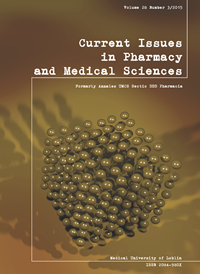TLC-densitometric analysis of α-escin in bulk drug substance and in pharmaceutical dosage forms
DOI:
https://doi.org/10.1515/cipms-2015-0069Keywords:
α-escin, densitometry, triterpene compoundsAbstract
A quite simple and rapid TLC-densitometric method for the identification of α-escin (Aescin) in bulk drug substances was developed. In so doing, different chromatographic conditions, including various mobile and stationary phases, were tested. A TLC-densitometric determination of the examined compound was performed without using visualizing reagent, yet with the use of appropriate dipping reagents, in order to obtain reliable UV-densitometric measurements of α-escin – a substance which has weak chromophore groups. Herein, the application of a mobile phase containing n-butanol-acetic acid-water in volume composition 30:7:13, the use of silica gel 60F254 plates with concentrating zone, and subsequent application of 10% sulphuric acid in ethanol or 5% vanillin in methanol/sulphuric acid, respectively, provided the best results in a TLC-densitometric study of α-escin. The described method was successfully employed to identify α-escin in commercial samples that were in an oral dosage form (tablets) and also in the form of gel containing 20 mg of α-escin.
References
1. Acar, A. M., Paksoy, S.: Derivative spectrophotometric determination of escin in Aesculus hippocastanum L. seeds. Pharmazie, 48, 65-66, 1993.
2. Apers, S., et al.: Densitometric thin-layer chromatography chromatographic determination of aescin in a herbal medicinal products containing Aesculus and Vitis dry extracts. J. Chromatogr., A. 1112, 165-170, 2006.
3. Connolly, J. D1. Acar, A. M., Paksoy, S.: Derivative spectrophotometric determination of escin in Aesculus hippocastanum L. seeds. Pharmazie, 48, 65-66, 1993.
2. Apers, S., et al.: Densitometric thin-layer chromatography chromatographic determination of aescin in a herbal medicinal products containing Aesculus and Vitis dry extracts. J. Chromatogr., A. 1112, 165-170, 2006.
3. Connolly, J. D, Hill, R. A.: Triterpenoids. Nat Prod Rep., 27(1), 79-132, 2010.
4. Costantini, A.: Escin in pharmaceutical oral dosage forms: quantitative densitometric HPTLC determination. II Farmaco, 54, 728-732, 2013.
5. European Pharmacopoeia, 6th Ed. 20(3), 478-481, European Pharmacopoeia Commission, UK, London, 2008.
6. Gołembiewska, E., et al.: Methods for the isolation and identification of triterpenes and sterols in medicinal plants. Curr. Issues Pharm. Med. Sci., 26(1), 26-32, 2013.
7. Lindner, I., et al.: Betα-escin has potent anti-allergic efficacy and reduces allergic airway inflammation. BMC Immunol., 21, 11-24, 2010.
8. Liu, L., et al.: A liquid chromatography-tandem mass spectrometry method for the simultaneous quantification of escin Ia and escin Ib in human plasma: application to a pharmacokinetic study after intravenous administration. Biomed. Chromatogr., 24, 1309-1315, 2010.
9. Man, S.: Chemical study and medical application of saponins as anti-cancer agents. Fitoterapia, 81(7), 703-714, 2010.
10. Rao, A. V, Gurfinkel, D. M.: The bioactivity of saponins: triterpenoid and steroidal glycosides. Drug Metabol Drug Interact., 17(1-4), 211-235, 2000.
11. Sirtori, C. S.: Aescin: pharmacology, pharmacokinetics and therapeutic profile. Pharmacol. Res., 44 (3), 183-193, 2001.
12. Vujic, Z.: Optimization of the extraction process of escin from dried seeds of Aesculus hippocastanum L. by Derringer’s desirability function. J. Anim. Plant Sci., 17(1), 2514 -2521, 2013.
13. Waksumundzka-Hajnos, M., et al.: Thin Layer Chromatography in Phytochemistry. TLC of Triterpenes (Including Saponins). 20, 519-537, CRC Press, Boca Raton, 2008.
14. Wu, X. J., et al.: Comparative pharmacokinetics and the bioavailabil¬ity of escin Ib and isoescin Ib following the administration of escin, pure escin Ib and isoescin Ib in rat. J Ethnopharm. 139, 201-206, 2012.
15. Zhang, M., et al.: Simultaneous Determination of escin Ia and Its isomer isoescin Ia by LC–MS–MS: Application to a pharmacokinetic study of escin Ia in rats. Chromatographia. 74 (3-4), 243-250, 2011.
16. Zhou X. Y., et. al.: Escin, a natural mixture of triterpene saponins, exhibits antitumor activity against hepatocellular carcinoma. Planta Med. 75(15), 1580-1585, 2009.
Downloads
Published
Issue
Section
License
Copyright (c) 2015 Authors

This work is licensed under a Creative Commons Attribution-NonCommercial-NoDerivatives 3.0 Unported License.


